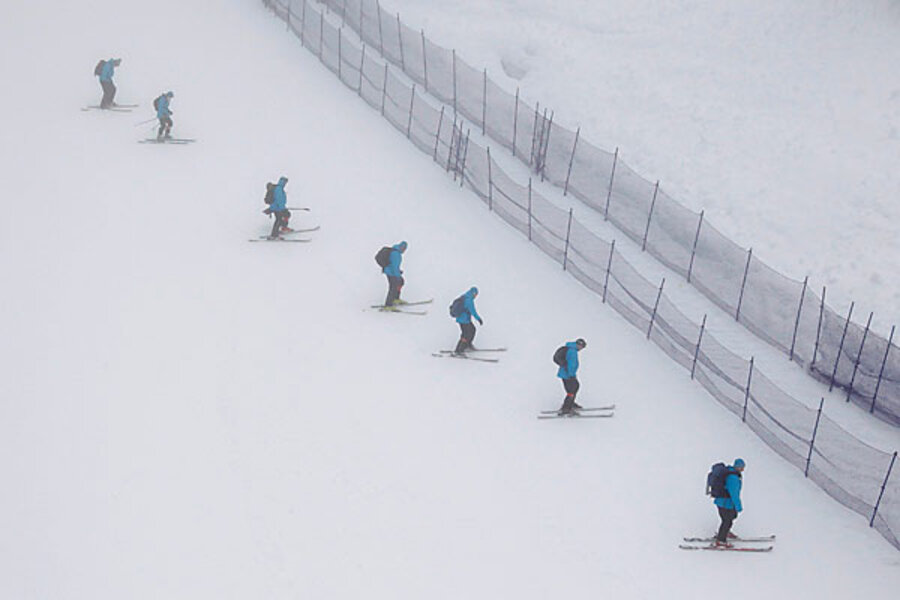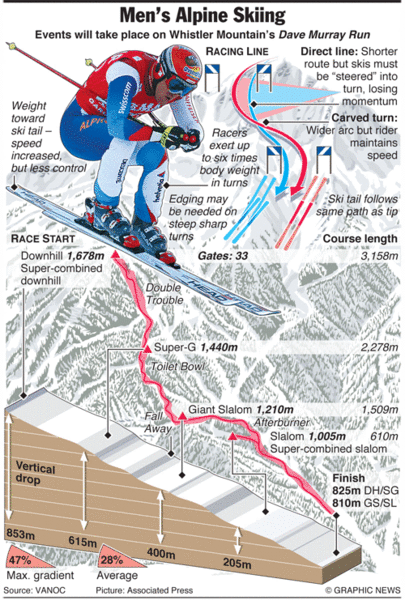Weathering the Olympics: how science and sport meet on the bottom of a ski
Loading...
| Whistler, British Columbia
With unseasonably warm weather drenching Whistler in rain and slush, the men’s super combined race on Tuesday became the third of three scheduled alpine skiing events to be postponed due to poor conditions.
But while Olympians here can’t count on their races being held as planned, one thing they can be sure of is that the X factor of their sport – the detailed science behind how skis and snowboards run fast on snow – just got a lot bigger.
Many of the athletes here have trained a decade or more. But their shot at an Olympic medal could be determined by a fraction of a second. And those fractions can be won or lost depending on something most spectators never see: the base of an athlete's skis or snowboard.
That is because the thing we casually refer to as snow is transformed by variables such as humidity, temperature, and density that significantly affect what will run fastest in a given condition. Warm, wet conditions have characterized nearly every day of competition so far at the Games.
"The more extreme the conditions, the more important it is what we do," says Knut Nystad, who leads Norway’s team of 22 wax technicians and ski testers – just for cross-country. "The equipment makes a huge difference. You can spend 10,000 hours training, but what we do can give you that extra 10 or 20 seconds. This is what makes the difference between the second-best and the best athletes."
450 pairs of skis for 12 athletes
Skis with a softer flex perform better in softer snow, while springier skis are needed in harder conditions; different base structures are needed depending on the water content and temperature of the snow; and then there’s the glide wax that goes on on race day. Skiers often have a quiver of 20 pairs or more of competition skis; the German biathlon team brought 450 pairs in Whistler for their 12 athletes.
So crucial is it for technicians to accurately adapt skiers’ equipment to the conditions that Nystad’s team spent six weeks here in Whistler in 2008 and again in 2009. The US team had someone living here for the past few winters, testing different skis and waxes, for the same reason. But no one has gone as far as the Canadians, who under the $8 million Top Secret program – a subset of their ambitious Own the Podium push – have had professors and PhD students from the University of British Columbia (UBC) in Vancouver working full-time on the problem for 3-1/2 years.
Just before Christmas, they unveiled their secret weapon: a new base for skis and snowboards that reduces friction by 20-25 percent – a huge margin given that races can be won by a toenail. Snowboarders have already used it on the World Cup, but no one will say much about what the secret ingredient is, which was produced by UBC and hand-carried to manufacturers in Europe, who integrated it into their design.
“The magic stuff that we put in the ski base is still [not known],” says UBC plastics expert Savvas Hatzikiriakos, who will say only that he experimented with additives normally used to help plastics slip out of molds. What is known for sure, though, is that the secret missiles work best on the suction-like snow found at the snowboard venue, Cypress Mountain, and up here in Whistler. “The new base works better in the warmer conditions, especially if the snow is wet … the wetter, the better.”
The Teflon effect
That’s because the new bases act like Teflon, causing the water droplets to make tiny beads, instead of something like glass, which creates more of a pancake-shaped droplet, explains Sheldon Green, who oversaw a parallel research project at UBC.
The more skis and snowboards act like a Teflon pan, the more freely they can glide across the snow – especially in wet conditions, when they’re basically gliding on a thin film of water.
It’s a complicated study, admits Green, an expert in “microscopic snow friction” – in other words, the nitty-gritty science behind why snow creates drag on skis and snowboards.
Linguist Steven Pinker has written that Eskimos have a dozen words for snow, and there’s a reason why. "Snow" is everything from newly-fallen sharp crystals to rounded balls that have been frozen, thawed, rained on, and then baked by a sunny day. So Green’s task, along with his researcher, has been to figure out how to make a ski glide best in any possible condition. A key tool in that process is choosing the right glide wax out of hundreds of options.
Nystad, the Norwegian technician, knows that all too well.
“It's a fair portion of science and a good portion of gut feeling of what is going to run today,” says Nystad, noting that everything they do is secret, too. “We're not doing an exact science – it's very empirical.”
Indeed, for decades ski coaches have closely collected the results of their meticulous testing of both glide wax and kick wax, which keeps cross-country skis from slipping backward on uphills and must all be matched to the snow-crystal shape. Jotting down penciled notes in a daily journal with hands numb and dry from the cold, they develop a vast knowledge base that is highly prized by skiers and fellow technicians.
“I have the best [wax technician] in the world,” said US snowboarder Nate Holland ahead of yesterday’s event, in which he narrowly missed the bronze medal. “My board is never the problem. It's a freakin' rocket ship."
Teammate Graham Watanabe agreed. “Wax teching is an absolute art. He [USA team wax tech] has been killing it all year long.”
In cross-country, biathlon, and Nordic combined races, a bad wax job can cost even the best skier a minute or more, so it’s critical to find the right concoction.
But Green and his researcher have tried to take some of the guesswork out of the game with a database that allows technicians to type in roughly 18 variables and then spits out recommendations.
Still, it’s not going to be easy at the Nordic venues in Whistler, said US cross-country skier Kris Freeman ahead of the races: “It’s the hardest venue in the world to wax for.”
______________
Christa knows how important the right wax is – she trained fulltime for the Olympics from 1997-2002 in cross-country skiing. Follow her as she tweets throughout the Games.






